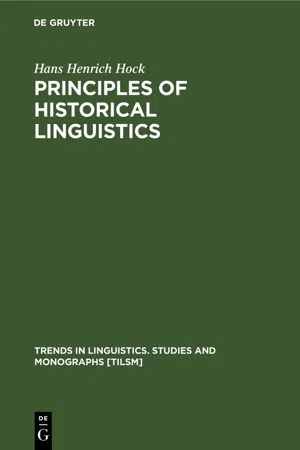
- 757 pages
- English
- PDF
- Available on iOS & Android
Principles of Historical Linguistics
About this book
Historical linguistic theory and practice contains a great number of different 'layers' which have been accepted in the course of time and have acquired a permanency of their own. These range from neogrammarian conceptualizations of sound change and analogy to present-day ideas on rule change and language mixture. To get a full grasp of the principles of historical linguistics it is therefore necessary to understand the nature and justifications (or shortcomings) of each of these 'layers', not just to look for a single 'overarching' theory. The major purpose of the book is to provide in up-to-date form such an understanding of the principles of historical linguistics and the related fields of comparative linguistics and linguistic reconstruction. In addition, the book provides a very broad exemplification of the principles of historical linguistics.
Frequently asked questions
- Essential is ideal for learners and professionals who enjoy exploring a wide range of subjects. Access the Essential Library with 800,000+ trusted titles and best-sellers across business, personal growth, and the humanities. Includes unlimited reading time and Standard Read Aloud voice.
- Complete: Perfect for advanced learners and researchers needing full, unrestricted access. Unlock 1.4M+ books across hundreds of subjects, including academic and specialized titles. The Complete Plan also includes advanced features like Premium Read Aloud and Research Assistant.
Please note we cannot support devices running on iOS 13 and Android 7 or earlier. Learn more about using the app.
Information
Table of contents
- Preface
- Contents
- Maps and charts
- 1. Introduction
- 2. Phonetics, transcription, terminology, abbreviations
- 3. Sound change: The regularity hypothesis
- 4. Sound change and phonological contrast
- 5. Sound change: Assimilation, weakening, loss
- 6. Sound change: Dissimilation, haplology, metathesis
- 7. Sound change: Epenthesis, elimination of hiatus, other changes
- 8. Sound change: Structure and function
- 9. Analogy: General discussion and typology
- 10. Analogy: Tendencies of analogical change
- 11. Analogy and generative grammar
- 12. Semantic change
- 13. Syntactic change
- 14. Linguistic contact: Lexical borrowing
- 15. Linguistic contact: Dialectology
- 16. Linguistic contact: Koinés, convergence, pidgins, creoles, language death
- 17. Internal reconstruction
- 18. Comparative method: Establishing linguistic relationship
- 19. Comparative reconstruction
- 20. Linguistic change: Its nature and causes
- Notes
- References
- Index